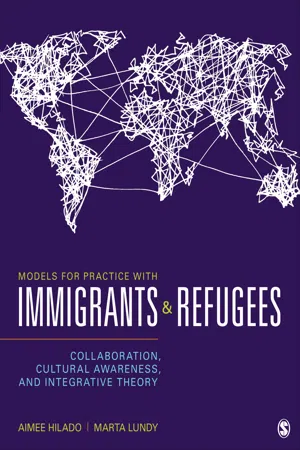
Models for Practice With Immigrants and Refugees
Collaboration, Cultural Awareness, and Integrative Theory
Aimee Hilado, Marta Lundy
- 472 páginas
- English
- ePUB (apto para móviles)
- Disponible en iOS y Android
Models for Practice With Immigrants and Refugees
Collaboration, Cultural Awareness, and Integrative Theory
Aimee Hilado, Marta Lundy
Información del libro
Designed to establish a foundational framework for working with trauma-exposed immigrants and refugees, this important work introduces innovative approaches to address client mental health problems while supporting adjustment to life in a new country. This practice-oriented book emphasizes the relevance of Western approaches while reorienting Western concepts to be more culturally sensitive from a domestic and international perspective. Grounded in critical thinking and strengthened by an ecological systems perspective, the book presents six different models for applying and integrating Western theory and related practice strategies for working with individuals, families, groups, communities, organizations, volunteers, and local workforces.
Preguntas frecuentes
Información
Chapter 1 Defining The Immigrant And Refugee Populations
Key Terms
Chapter Highlights
- Differences between immigrants, refugees, and asylees
- Reasons for deportation/removal
- Obtaining citizenship
Key Terms
Nonimmigrant and Immigrant.
Refugee and Asylee.
Owing to well-founded fear of persecution for reasons of race, religion, nationality, membership of a particular social group or political opinion, is outside the country of his nationality and is unable or, owing to such fear, is unwilling to avail himself of the protection of that country.
Assessment/Eligibility Stage
- Have a well-founded fear of persecution on account of race, religion, national origin, political opinion, or membership in a particular social group
- Must apply for asylum within one year of most recent arrival to the United States. If the applicant is applying AFTER the one-year deadline, service providers can help with applying for a waiver of the failure to meet the deadline (grounds for possible exemptions or waivers will be described below)
Fear.
Índice
- Cover
- Half Title
- Acknowledgements
- Publisher Note
- Title Page
- Copyright Page
- Contents
- Preface
- About the Editors
- Contributing Authors
- UNIT I Defining Immigrant And Refugee Populations
- Chapter 1 Defining The Immigrant And Refugee Populations
- Chapter 2 The Context Of Migration: Pre-Arrival, Migration, and Resettlement Experiences
- Chapter 3 Physical And Mental Health Stabilization: The Importance of Well-Being to the Adjustment of New Immigrants
- Unit II Theoretical Orientations and Reorientation
- Chapter 4 Transnational Practice as the Client’s Process: Reorienting Practice With an Integrative Theoretical Approach to Practice With Immigrants and Refugees
- Chapter 5 The Perception and Experience of Everyday Discrimination Among U.S. Immigrants
- Chapter 6 Postcolonial Feminist Social Work Perspective: Additional Considerations for Immigrant and Refugee Populations
- Unit III Intervention Modalities Using an Integrative Approach
- Chapter 7 Practice with Individuals
- Chapter 8 Practice With families
- Chapter 9 Support and Psychoeducational Groups for Immigrant Women: A Working Model
- Chapter 10 Community Practice
- Chapter 11 Organizational Practice
- Chapter 12 Preparing a Local and Volunteer Workforce
- UNIT IV Practice Applications With Vulnerable and Trauma-Exposed Immigrants and Refugees
- Chapter 13 Defining Trauma: Practice Applications With Vulnerable and Trauma-Exposed Immigrant Populations and Survivors of Torture
- Chapter 14 Practice Applications With Women
- Chapter 15 Practice Applications With LGBTQ Immigrants and Refugees
- Chapter 16 Practice Applications With Immigrant and Refugee Youth
- Unit V Consolidation
- Chapter 17 Maintaining Critical Consciousness, Collaborative Accompaniment, and Cultural Humility: The Common Denominators of Transnational Practice
- Chapter 18 Social Justice and Implications for the Field
- APPENDIX I Resource List: Working With Immigrants, Refugees, and Asylees
- APPENDIX II Universal Declaration of Human Rights
- APPENDIX III Sample Assessment Outline
- APPENDIX IV Warning! Protect Yourself From Immigration Raids!
- APPENDIX V Safety Planning for Survivors of Violence
- INDEX